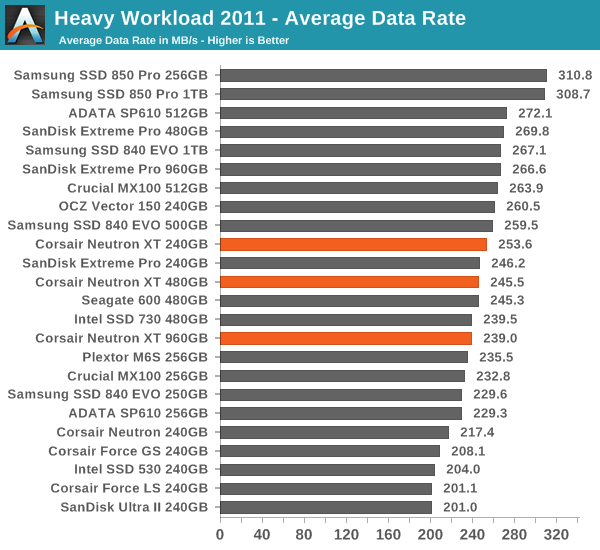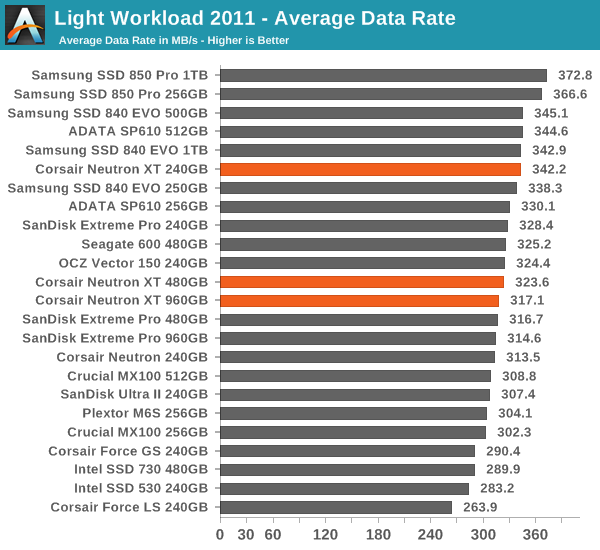Corsair Neutron XT (240GB, 480GB & 960GB) SSD Review: Phison S10 Debuts
by Kristian Vättö on November 17, 2014 9:00 AM ESTAnandTech Storage Bench 2011
Back in 2011 (which seems like so long ago now!), we introduced our AnandTech Storage Bench, a suite of benchmarks that took traces of real OS/application usage and played them back in a repeatable manner. The MOASB, officially called AnandTech Storage Bench 2011 – Heavy Workload, mainly focuses on peak IO performance and basic garbage collection routines. There is a lot of downloading and application installing that happens during the course of this test. Our thinking was that it's during application installs, file copies, downloading and multitasking with all of this that you can really notice performance differences between drives. The full description of the Heavy test can be found here, while the Light workload details are here.

The same story continues in our 2011 Storage Benches. The Neutron XT is an upgrade – and actually a fairly substantial one – from the Force LS, but it doesn't break any records. Also, what's a bit surprising is that the performance drops as the capacity increases because the 240GB is the fastest of the Neutron XT family. This isn't uncommon because the larger capacities have more LBAs to track, which requires more processing power for internal tasks, but it's still something that's worth noting.











56 Comments
View All Comments
hojnikb - Monday, November 17, 2014 - link
Because they are using samsung's controllers. And they already have pci-e controllers.close - Monday, November 17, 2014 - link
Because Apple only has to worry about their own product, and their PCIe SSDs come attached to a device capable of using it. So you don't buy a PCIe SSD, you buy an Apple device that comes with a PCIe SSD inside. Other integrators/OEMs don't care to do it as it increases costs so it's suitable only for high end. For now. Apple is doing it because it would seem that their customers can afford to pay the premium regardless of other aspects.Kristian Vättö - Monday, November 17, 2014 - link
There has been a handful of PCs with the XP941, but you are right that Apple is mostly the only one.The PC OEMs tend to cut in cost wherever possible because their margins are already razor thin. The XP941 is more expensive than SATA drives because it's the only PCIe x4 drive on the market and in addition the PC OEMs can use the same SATA drives in various models, whereas the XP941 would only fit in high-end models due to the cost.
For Apple this isn't an issue because the quantities they buy the XP941 in are so large and Apple also has a significant share of the high-end market, which is where the PC OEMs struggle. Plus Apple is one of the only companies that fully understand that it's the user experience that counts.
alaricljs - Monday, November 17, 2014 - link
> Plus Apple is one of the only companies that fully understand that it's the user experience that counts.Have to point out here that Apple is one of the only companies where the hardware is just another piece of the user experience puzzle that they have control over. Whereas for PC manufacturers it's almost the only part of the user experience they have control over.
Mikemk - Monday, November 17, 2014 - link
Apple needs to realize that again.warrenk81 - Tuesday, November 18, 2014 - link
thanks! i've been wondering about this since the MacBook Airs started with the PCIe SSDs in 2013.Shiitaki - Wednesday, November 19, 2014 - link
Apple produces the entire machine, so they don't have to worry about what the rest of the industry is or isn't doing. Because Apple can put the necessary driver support in their motherboard firmware to boot from a PCI-E drive. Apple also produces the operating system, so they can use a custom driver and not wait for 'official support'.Flunk - Monday, November 17, 2014 - link
Oh god I hope not, SATA Express' cable standards are a huge mess I hope we never need to deal with. Why we need yet another standard where M.2 makes massively more sense I can't imagine.SleepyFE - Monday, November 17, 2014 - link
Because of the cable. When you have a tower case you can fit 5+ drives in it and connect via cable. The M.2 is just for laptops as it has to be fixed at the end with a screw an therefor has to lay on something. To put it on an ATX motherboard would take up too much space or it would dangerously dangle from the board. You could use a M.2 to PCI-e connector, but why waste the PCI-e slot? And what's the point of M.2 if you're just gonna plug it into PCI-e anyway? For big cases you need cables. They might be a mess, but you can use the SATA-X (-X= Express) for the boot drive and put all your old drives into SATA ports, so you don't waste them.MrSpadge - Monday, November 17, 2014 - link
It's a bit surprising that it takes so long - not because it would be easy, but because we've known since a long time this would be coming. The manufacturers should have known it long before us. And it's not like there has been any other significnat movement regarding SSD controllers in the past 2 years.On the other hand - I don't mind if they take their time and deliver polished products with firmware which is not in beta state any more!